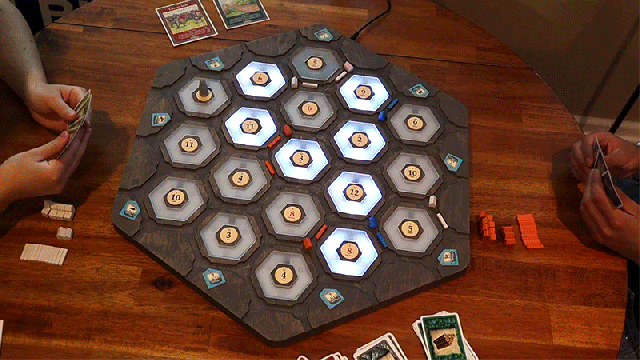The board game formerly known as Settlers of Catan isn’t hard to learn, but there are elements that are hard to master, like always remembering to claim resource cards after the dice is rolled. Sam March’s gorgeous custom Catan board solves that with tiles that automatically light up so it’s much easier for players to know when a dice roll falls in their favour.
As one of the most popular board games to come along in the past quarter-century, Catan has sold over 32 million copies, but it’s also spawned countless custom versions created by fans looking for a more elaborate and engrossing way to play the game. That includes versions featuring 3D recreations of the game’s various terrains, and Catan boards made from expensive woods instead of the cardboard pieces it ships with. There’s a lot of room for expression and customisation, but March’s custom board cleverly incorporates electronics that improve gameplay while still preserving what makes Catan so enjoyable.
Unofficially nicknamed “Fancy Schmancy Settlers” (although also referred to as “smarchSettlers” elsewhere) March’s game board replaces the standard hexagonal tiles made of cardboard with a solid board that was CNC milled from several layers of birch plywood, which were stacked and glued together. The game’s high replay value is partly due to the fact that the hexagonal game tiles can be re-arranged every time, but instead of having to assemble them manually, March replaced the tiles with 19 custom-designed PCBs each featuring LEDs that can simply change colour to indicate what resources they produce. When the Catan board is powered on, a random arrangement of the tiles is automatically created, based on how the original game plays.
Unlike board games like Monopoly, where each roll of the die determines where a player can move, die rolls in Catan instead indicate which tiles on the board are active, and in turn, which players can collect the resources they need to help build and expand their empires. In the original version of the game, players scour the board after every roll to determine which tiles are active based on a numbered token placed atop them, but March’s custom board does the dice rolling all by itself and then automatically lights up only the active tiles, making it very obvious for players to know when they’re able to collect resource cards.
March has provided all of his designs and custom code as open-source materials that are freely available for download on GitHub, but if you’re hoping to upgrade your own Catan experience, you’ll need to be aware that this is far from a one-day build. There are materials to source, custom PCBs to manufacture, soldering, and if you don’t have access to a milling machine, making the base for the actual board is going to require lots of manual woodworking — with no settlers to lend a hand.
